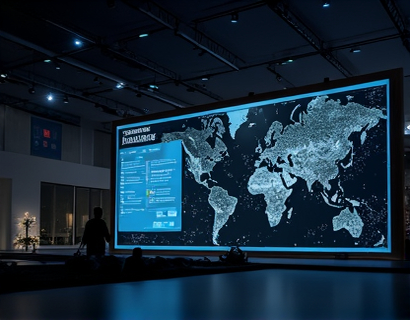Next-Gen QR Code Technology: Revolutionizing Business and Social Media Engagement for Modern Enterprises
In the rapidly evolving digital landscape, businesses and social media managers are constantly seeking innovative solutions to enhance engagement and streamline interactions with their audience. One such technology that has emerged as a game-changer is next-generation QR code technology. This advanced form of QR codes is not just an improvement over the traditional version but a complete reimagining of how information can be shared, accessed, and interacted with. These next-gen QR codes are customizable, intuitive, and designed to revolutionize the way modern enterprises connect with their audience, making them an essential tool for anyone looking to boost their digital presence and foster deeper relationships with customers and followers.
The Evolution of QR Codes
QR codes, or Quick Response codes, were first developed in the 1990s as a method to track vehicle parts in manufacturing. Over the years, they have found widespread use in various sectors, from marketing and advertising to logistics and identity verification. Traditional QR codes have been instrumental in providing a quick and easy way to access information by simply scanning a code with a smartphone. However, as technology advanced, the limitations of these codes became apparent. They were static, lacked customization, and often resulted in a disjointed user experience. This is where next-generation QR code technology steps in, offering a suite of features that address these shortcomings and more.
Customization and Personalization
One of the most significant advancements in next-gen QR codes is the level of customization they offer. Unlike traditional QR codes, which are typically monochromatic and lack any design flexibility, next-gen codes can be tailored to match a brand's identity. This includes custom colors, logos, and even shapes. For businesses, this means that QR codes can be seamlessly integrated into marketing materials, product packaging, and physical store environments, enhancing brand visibility and recognition. Customization also extends to the content linked to the QR code, allowing for dynamic updates without the need to print new codes. This flexibility ensures that the information remains current and relevant, keeping the audience engaged and informed.
Enhanced User Experience
The user experience is a critical factor in the success of any digital tool, and next-gen QR codes excel in this area. These codes are designed to be more user-friendly, with larger and more readable formats that can be scanned quickly and accurately, even in low-light conditions. The integration of augmented reality (AR) technology is another notable feature. When a user scans a next-gen QR code, they can be transported to an AR experience that provides interactive and immersive content. This could range from virtual product demonstrations to interactive games and contests, significantly enhancing user engagement and satisfaction.
Dynamic Content and Real-Time Updates
Traditional QR codes link to static URLs, meaning that any changes to the linked content require the QR code itself to be updated. Next-gen QR codes, however, support dynamic content, allowing for real-time updates to the information they direct users to. This means that businesses can push out the latest promotions, news, or updates without the need for physical changes to the QR code. For example, a retail store can update the QR code on its window display to reflect seasonal sales or new arrivals instantly, ensuring that customers always have access to the most current information.
Multi-Platform Compatibility
In today's multi-device world, ensuring that digital tools work seamlessly across various platforms is crucial. Next-gen QR codes are designed to be compatible with both iOS and Android devices, as well as other platforms like tablets and smart watches. This universality ensures that users can access the linked content regardless of the device they are using, broadening the reach and effectiveness of engagement strategies. Additionally, these codes can be optimized for different screen sizes and resolutions, providing a consistent and high-quality experience across all devices.
Security and Trust
Security is a paramount concern in the digital age, and next-gen QR codes address this by incorporating advanced security features. These codes can include encrypted links and secure authentication methods, ensuring that the information users access is safe and trustworthy. For businesses, this builds consumer confidence and protects against potential security breaches. Moreover, the ability to track scans and monitor user interactions provides valuable insights into customer behavior, helping businesses refine their strategies and improve user trust.
Integration with Digital Marketing Strategies
Next-gen QR codes are not just standalone tools but can be seamlessly integrated into broader digital marketing strategies. They can be used in conjunction with social media campaigns, email marketing, and in-store promotions to create a cohesive and engaging customer journey. For instance, a brand can place QR codes on its social media posts, encouraging followers to scan for exclusive content or discounts. This not only drives traffic to the brand's digital platforms but also enhances the overall customer experience by providing a seamless transition from online to offline interactions.
Case Studies and Success Stories
Several businesses have already leveraged next-gen QR code technology to achieve remarkable results. A prominent fashion brand, for example, integrated custom QR codes into its clothing tags, linking to virtual try-on experiences and detailed product information. This not only reduced return rates by providing customers with a better understanding of the products but also increased online sales by driving traffic to the brand's e-commerce platform. Another case involves a local restaurant chain that used QR codes on its menus to offer customers interactive recipes and cooking tips, enhancing customer engagement and loyalty.
Challenges and Considerations
While the benefits of next-gen QR code technology are clear, there are several considerations businesses should keep in mind. First, the initial setup and integration can require technical expertise, especially for those unfamiliar with digital marketing tools. However, many platforms offer user-friendly interfaces and support to ease this process. Additionally, while customization is a strength, it's important to ensure that the QR codes remain recognizable and functional across different environments and conditions. Testing and optimization are key to ensuring a smooth user experience.
Future Trends and Innovations
The future of QR code technology is promising, with ongoing innovations set to further enhance its capabilities. One area of development is the integration of 5G technology, which will enable faster data transfer and more complex interactions. This could lead to more sophisticated AR experiences and real-time data analytics. Additionally, the incorporation of blockchain technology could provide even higher levels of security and transparency, making next-gen QR codes an even more reliable tool for businesses and consumers alike.
Conclusion
Next-gen QR code technology represents a significant leap forward in how businesses and social media managers can engage with their audience. By offering customizable, secure, and dynamic solutions, these codes are poised to transform the way information is shared and interacted with in the digital space. As more enterprises recognize the potential of next-gen QR codes, we can expect to see a widespread adoption that will drive greater connectivity, enhance customer experiences, and ultimately foster deeper brand relationships.










































